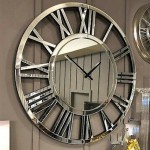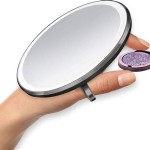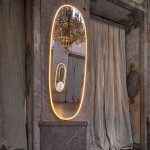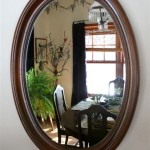Mirror In The Bathroom: A Reflection of Form and Function
The bathroom mirror serves a vital, everyday purpose. More than a mere reflective surface, it plays a significant role in hygiene routines, personal grooming, and the overall aesthetic of the bathroom space. Understanding the various types, materials, and installation considerations can help homeowners select the ideal mirror to enhance both functionality and design.
Bathroom mirrors are available in a wide array of shapes and sizes. Common shapes include rectangular, square, round, and oval. The size selection depends largely on the available wall space and the desired visual impact. Larger mirrors can create the illusion of a more spacious bathroom, while smaller mirrors offer a more focused reflection for tasks like applying makeup or shaving.
Mirrors are typically constructed from one of several types of glass. The most common and affordable option is standard annealed glass. While cost-effective, annealed glass can be hazardous if broken, shattering into sharp shards. For added safety, tempered glass is a preferred choice. Tempered glass is heat-treated to increase its strength and, upon breaking, crumbles into relatively harmless, granular pieces.
The reflective coating on the back of the mirror is crucial for its performance. Silvering is the traditional method, involving applying a thin layer of silver onto the glass, followed by protective coatings of copper and paint. Modern mirrors often utilize aluminum as the reflective coating, offering a cost-effective alternative to silver. The quality of the reflective coating impacts the clarity and accuracy of the reflection.
Beyond the basic mirror itself, various features and enhancements are available. Illuminated mirrors, incorporating built-in lighting, offer improved visibility for grooming tasks. These can range from simple LED strips around the perimeter to more sophisticated backlighting that diffuses light evenly across the mirror surface. Magnifying mirrors provide a closer, detailed view, useful for tasks like tweezing or applying eyeliner.
Anti-fog mirrors address the common issue of condensation obscuring the reflection after a hot shower. These mirrors incorporate a heating element, either integrated within the glass or attached to the back, that gently warms the mirror surface to prevent condensation from forming. This feature can be especially beneficial in bathrooms with limited ventilation.
The framing of the bathroom mirror contributes significantly to its overall aesthetic. Frameless mirrors offer a sleek, modern look, seamlessly integrating into the bathroom design. Framed mirrors, available in a variety of materials such as wood, metal, and plastic, can add a decorative touch and complement the existing bathroom décor. The frame material should be chosen considering the bathroom's humidity and potential exposure to water.
Proper installation is crucial for the longevity and safety of the bathroom mirror. The chosen mounting method should be appropriate for the mirror's size and weight. For heavier mirrors, specialized hardware and wall anchors might be necessary to ensure a secure and stable installation. Careful consideration should be given to the mirror's placement in relation to lighting fixtures and other bathroom elements.
Beyond functionality, the bathroom mirror can contribute to the overall design and ambiance of the space. Strategically placed mirrors can enhance natural light and create the illusion of a larger bathroom. The mirror's shape, size, and frame can complement the existing décor, whether it's a minimalist, contemporary style or a more traditional aesthetic.
Maintaining the cleanliness of the bathroom mirror is essential for optimal performance and hygiene. Regular cleaning with a glass cleaner and a soft cloth will remove smudges, water spots, and other blemishes. Avoid using abrasive cleaners, which can scratch the mirror surface. For stubborn stains, a mixture of vinegar and water can be an effective cleaning solution.
Choosing the right bathroom mirror involves considering various factors, from practical functionality to aesthetic appeal. By understanding the different types of mirrors available, the materials used in their construction, and the various features and enhancements, homeowners can make informed decisions that enhance both the utility and the design of their bathroom space.
The placement of the mirror within the bathroom should also be carefully considered. The mirror should be positioned at a height that accommodates all users of the bathroom. Adequate lighting around the mirror is crucial for tasks such as shaving and applying makeup. Natural light is ideal, but supplemental lighting fixtures may be necessary to ensure sufficient illumination.
In conclusion, the bathroom mirror is more than just a functional object; it's an integral part of the bathroom's design and ambiance. Selecting the right mirror involves considering various factors, from size and shape to frame materials and added features. By carefully evaluating these aspects, homeowners can create a bathroom space that is both functional and aesthetically pleasing.
Advantages Of Using Mirrors In The Bathroom

Ideal Bathroom Mirror Placement Where Should It Go Vanders Glass

Why Bathroom Mirrors Are So Important

Using A Round Mirror In The Bathroom Majestic Glass
:strip_icc()/Design_CathieHongInteriorsPhoto_ChristyQPhotography-b2290decbe0e4d0b952f280fb7bdc896.jpg?strip=all)
How To Remove A Bathroom Mirror From The Wall

Round Backlit Led Heated Bathroom Mirror 800mm Luna Better Bathrooms

30 Cool Ideas To Use Big Mirrors In Your Bathroom Digsdigs

Antique Mirrors In A Bathroom Adding Charm Character

27 Bathroom Mirror Ideas For Every Style Wall Decor

Rock Your Reno With These 11 Bathroom Mirror Ideas








